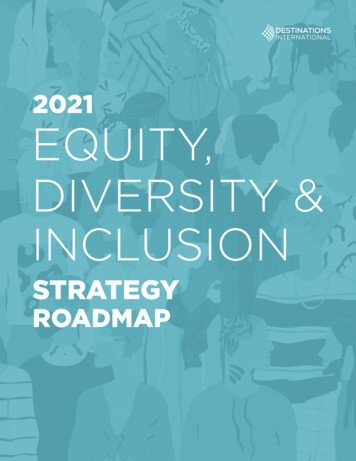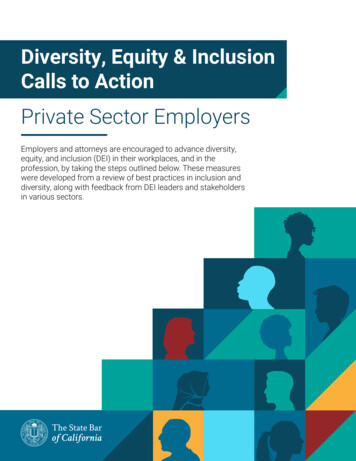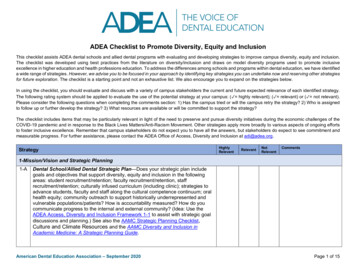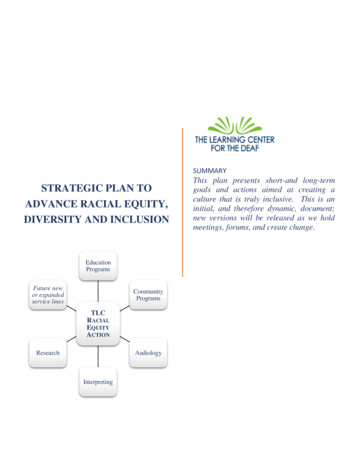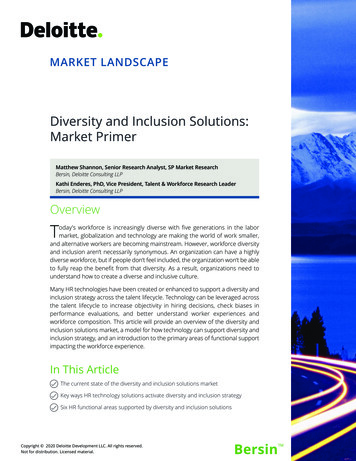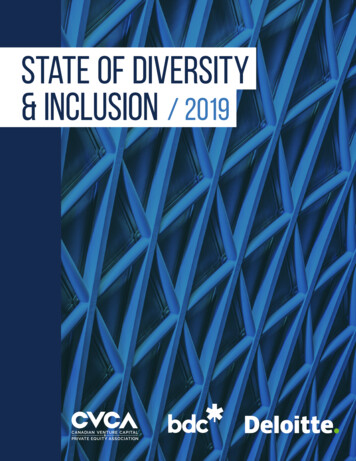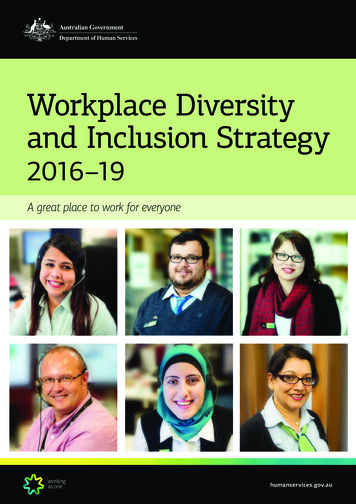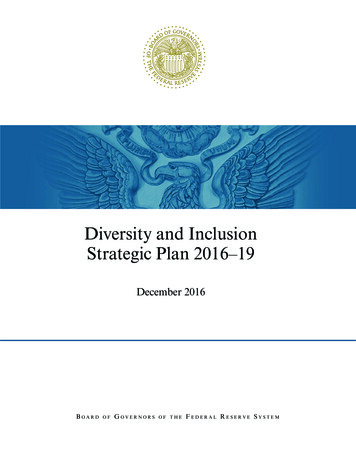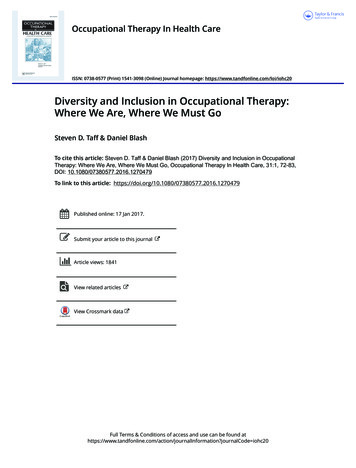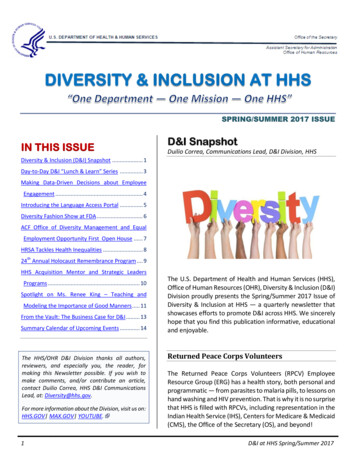
Transcription
DIVERSITY &AT HHSD&I SnapshotDuilio Correa, Communications Lead, D&I Division, HHSDiversity & Inclusion (D&I) Snapshot . 1Day-to-Day D&I “Lunch & Learn” Series . 3Making Data-Driven Decisions about EmployeeEngagement . 4Introducing the Language Access Portal . 5Diversity Fashion Show at FDA . 6ACF Office of Diversity Management and EqualEmployment Opportunity First Open House . 7HRSA Tackles Health Inequalities . 824th Annual Holocaust Remembrance Program . 9HHS Acquisition Mentor and Strategic LeadersPrograms . 10Spotlight on Ms. Renee King – Teaching andModeling the Importance of Good Manners . 11From the Vault: The Business Case for D&I . 13Summary Calendar of Upcoming Events . 14The HHS/OHR D&I Division thanks all authors,reviewers, and especially you, the reader, formaking this Newsletter possible. If you wish tomake comments, and/or contribute an article,contact Duilio Correa, HHS D&I CommunicationsLead, at: Diversity@hhs.gov.For more information about the Division, visit us on:HHS.GOV MAX.GOV YOUTUBE.1The U.S. Department of Health and Human Services (HHS),Office of Human Resources (OHR), Diversity & Inclusion (D&I)Division proudly presents the Spring/Summer 2017 Issue ofDiversity & Inclusion at HHS — a quarterly newsletter thatshowcases efforts to promote D&I across HHS. We sincerelyhope that you find this publication informative, educationaland enjoyable.Returned Peace Corps VolunteersThe Returned Peace Corps Volunteers (RPCV) EmployeeResource Group (ERG) has a health story, both personal andprogrammatic — from parasites to malaria pills, to lessons onhand washing and HIV prevention. That is why it is no surprisethat HHS is filled with RPCVs, including representation in theIndian Health Service (IHS), Centers for Medicare & Medicaid(CMS), the Office of the Secretary (OS), and beyond!D&I at HHS Spring/Summer 2017
In April 2017, the RPCV ERG finalized its Charter, andheld its first HHS-wide meeting with over 100participants! And there are many more people acrossHHS that the RPCV ERG plans to reach in the comingmonths.As Peace Corps Volunteers, they were dedicated toserving the communities in which they lived. As HHSemployees, they are dedicated to serving theAmerican people and protecting their health and wellbeing. As members of this ERG, their goal is to connectRPCVs from across HHS to promote this sharedmission of service.The goals of the Program are to assist HHS OperatingDivisions (OpDivs) and Staff Divisions (StaffDivs) in: Testing websites, Web pages, Web applications,widgets, documents, and email blasts for 508compliance Providing guidance on how to correct 508 issueswithin existing websites and documents Empowering OPDIVs with the knowledge andresources to ensure the compliance of futurewebsites through various training sessions andmaterialsIf you are interested in joining, e-mail RPCV@hhs.gov.Diversity & Inclusion Fuels HHS Office ofInspector General Fraud-Fighting SuccessFor additional information regarding making filesaccessible, trainings, compliance and remediation,digital communication and technology products, andrelated resources, visit the Program’s site.Diversity & inclusion efforts to recruit and maintain adiverse workforce are essential to the Office of theInspector General’s mission to safeguard HHSprograms and protect patients.For software applications reviews and assistance,please consult Jaime Robinson, OS Section 508Coordinator at: Jaime.Robinson@hhs.gov.In the fight against health care fraud, the stakes arehigh. Diversity of thinking and perspective is key forfraud-fighting efforts when patient well-being andtaxpayer money is at risk, according to Special Agentin Charge Derrick L. Jackson, who heads investigationsin the HHS Office of Inspector General’s Atlantaregion.Staff PicksContinue reading on the HHS Blog.HHS DCD 508 ProgramSection 508 of the Rehabilitation Act of 1973, asamended in 1998 (29 U.S.C. § 794 (d)), requires that allwebsite content be accessible to people withdisabilities. This applies to Web applications, Webpages and all attached files on the intranet, as well as,internet.The DCD 508 Program is housed within the HHS Officeof the Secretary (OS), Assistant Secretary for PublicAffairs (ASPA), Digital Communications Division (DCD).2If you want to know more about diversity andinclusion, following are examples of free onlinetraining opportunities available via the HHS LearningManagement System .Bridging the Diversity Gap(Module: apd 01 a01 bs enus)This course focuses on what diversity is, how toleverage the diversity within the organization, and thebarriers that must be overcome to create a diversifiedworking environment.Your Role in Workplace Diversity(Module: apd 01 a02 bs enus)In this course, you will explore strategies to help youbecome aware of your attitudes toward diversity,increase your acceptance of diverse cultures, people,and ideas, and become an advocate for diversitywithin the workplace.D&I at HHS Spring/Summer 2017
The Day-to-Day D&I “Lunch & Learn” Series, is an initiative sponsored by the HHS/OHR Diversity and Inclusion(D&I) Division to help create a more inclusive environment at HHS. The objectives of this special series are to: Provide opportunity for discussion of day-to-day common interests, issues, and/or best practices;Increase interactive employee engagement throughout the Department; andEnhance HHS’ diversity & inclusion efforts.The series format consists of presentations by subject matter experts and extended Q&A. We continuouslyelicit topics for discussion from employees, using a human-centered design approach, in order to help usschedule future sessions.Wednesday, July 19, 2017DIVERSITY IN COMMUNICATIONPresenter: Carl A. Lucas Sr., EEO Director, Office for Civil Rights and Civil Liberties, U.S. Department ofHomeland Security (DHS)Location: Humphrey Building, Rm. 405-AWednesday, August 16, 2017RECOMMENDATIONS FOR DIVERSITY & INCLUSION TRAININGPresenter: Len Gerald, Diversity Program ManagerDiversity & Inclusion (D&I) Division, HHSLocation: Humphrey Building, Rm. 305-AWednesday, September 20, 2017BULLYING PREVENTION TECHNIQUESPresenter: Danny L. Dickerson, Director, Diversity & Inclusion Division, National Institutes of Health (NIH)Location: Humphrey Building, Rm. 405-AFor further information or to request reasonable accommodation call 202-260-6675 or e-mail: diversity@hhs.gov.Please be alert to location and remote access updates via HHS News E-Blasts.3D&I at HHS Spring/Summer 2017
Making Data-Driven Decisions about Employee EngagementLen Gerald, Diversity Program Manager, D&I Division, HHSWant to better understand your workforce? Do youwant accurate, timely, data to help you createeffective engagement programs for your employees?UnlockTalent.gov is an interactive tool, developed bythe U.S. Office of Personnel Management (OPM), inpartnership with several other Federal agencies, tohelp agency leaders and diversity practitioners makedata-driven decisions and design initiatives to createa culture of engagement and excellence across theFederal Government.Launched in 2015, UnlockTalent.gov is a tool thatboth the public and agency employees can use. ThisPortal contains data from both the Federal EmployeeViewpoint Survey (FEVS) and the Enterprise HumanResources Integration (EHRI) database, whichincludes a variety of workforce demographicinformation.Additionally, the latest update to the AgencyIndicators page on UnlockTalent.gov providesimportant data regarding the overall health ofFederal agencies including the New IQ (InclusionQuotient) results, Veterans status and Disabilitystatus, mission critical and STEM occupationalbreakouts, by gender and age, as well as Teleworkand Retirement Eligibility data.The Agency Indicators page enables leaders anddiversity practitioners to evaluate strengths andweaknesses, and utilize the data and information toimprove decision-making and create sustainableimprovements to the culture of the organization.Therefore, if you want to make data-driven decisionsto strengthen employee engagement, check outUnlocktalent.gov.Future updates will include: 4Community of Practice Update – reorganizingthe structure and content on the page to make itmore user-friendly and allow individuals toaccess content more easily and quickly. Addition of agency level data to the AgencyIndicators page – incorporate overall agencylevel data for the Departments/Large agenciesfor all metrics on the page Quarterly updates of the Enterprise HumanResources Integration (EHRI) dataTo access the Agency Indicators page, log-in toUnlockTalent.gov, and select the Agency Indicatorslink at the top. If you have not registered for the site,and select thego to www.UnlockTalent.gov,Register link at the top right of the page.D&I DID YOU KNOW?Federal Employment Total number of employees: 1,926,115 States with employees: 51 Top 5 States:-- California (158,007)-- Virginia (147,746)-- District of Columbia (144,726)-- Texas (135,408)-- Maryland (123,317)2016 Federal Employee Viewpoint Survey Number of large agencies: 37 Number of small agencies: 40 Number of survey respondents governmentwide: 407,800 Government-wide response rate: 46%Source: www.UnlockTalent.govIf you are interested in a future Day-to-Day D&I“Lunch & Learn” session focusing on the features andinformation found on UnlockTalent.gov, please reachout to us at Diversity@hhs.gov.D&I at HHS Spring/Summer 2017
Introducing the Language Access PortalBy Kelli Carrington, M.A., Director, Office of Communications and Public Liaison, National Institute on MinorityHealth and Health Disparities (NIMHD), NIHThe National Institute on Minority Health and HealthDisparities (NIMHD) is committed to addressing theselanguage barriers and to improving the healthliteracy and lives of everyone living in America. We’reexcited to announce a new tool, the Language AccessPortal, as a resource for the NIMHD researchcommunity, public and community healthprofessionals, healthcare providers, and others whowork with health disparity populations with LEP. Theportal improves access to cross-cultural andlinguistically appropriate health informationproduced by the National Institutes of Health (NIH),NIMHD, and other federal agencies.Many of us know what it’s like to feel overwhelmedduring a doctor’s visit by information about healthconditions, behavior recommendations andmedicines. For patients who don’t speak orunderstand English fluently, the situation can bemore than overwhelming—it can be dangerous.Patients with limited English proficiency (LEP) arenearly three times more likely to have an adversemedical outcome.1Language is one of the most significant barriers tohealth literacy, the ability to understand the basichealth information needed to make good healthdecisions. Patients who lack health literacy are oftenunable to read or understand written healthinformation or to speak with their healthcareproviders about their symptoms or concerns. Thesepatients are less likely to follow important healthrecommendations or be able to give informedconsent.2In addition, according to the U.S. Census Bureau,more than 1 in 5 U.S. residents do not speak Englishat home. Thus, of that group, about 4 in 10, or 25million people, have limited English proficiency.3Many people with limited proficiency also live inhouseholds where no one speaks English well.Consequently, there is not a translator readilyavailable to accompany them to doctor’s visits, whichcan present significant challenges.5The Language Access Portal pulls together healthresources from across NIH in selected languages,particularly those languages spoken by populationsexperiencing significant health disparities. As welaunch, the portal includes information in Spanish,Hindi, Tagalog, Korean, Chinese, Japanese, andVietnamese. The portal currently has languageresources for the following areas where healthdisparities have been identified: CancerCardiovascular Disease (CVD)DiabetesHIV/AIDSImmunizationsInfant MortalityThe Language Access Portal is an important tool tohelp people working with LEP populations providethe information necessary for patients to makeimportant health decisions. The portal will continueto evolve and incorporate new resources fromNIMHD, NIH and other government agencies as theybecome available, so keep checking back.By working together and using tools like theLanguage Access Portal, we can begin to tackle thesecommunication barriers and improve the health ofevery resident of this country.D&I at HHS Spring/Summer 2017
3.REFERENCES1.2.Divi, C., Koss, R.G., Schmaltz, S.P., Loeb, J.M. (2007)Language Proficiency and Adverse Events in US Hospitals:a pilot study. Int J Qual Health Care. 19 (2): 60-67.Lee, J.S., Pérez-Stable, E.J., Gregorich, S.E. et al. (2017).Increased Access to Professional Interpreters in theHospital Improves Informed Consent for Patients withLimited English Proficiency. J GEN INTERN MED.doi:10.1007/s11606-017-3983-4U.S. Census Bureau. Table S1601: 2011-2015 AmericanCommunity Survey 5-Year Estimates.Note: This article was reprinted with permission of theNational Institute on Minority Health and HealthDisparities (NIMHD). For more information visit theNIMHD Blog.Diversity Fashion Show at FDABy Duilio Correa, Communications Lead, D&I Division, HHSGroup Photo: Office of Lifecycle Drug ProductAs part of the Office of Lifecycle Drug Products’(OLDP) Holiday Party celebrations, the OLDP Divisionof Modified Release Products presented “The Colorsof the World - Diversity Fashion Show” to celebratethe diversity at FDA.The Fashion Show was well-received, and theaudience had the opportunity to see beautiful andunique costumes and learn about different culturesfrom around the world, including American, Indian,Chinese, Thai, African, Filipino and Irish.We live in an ever-growing society that is becomingmore and more diverse. Accordingly, the FDADiversity Fashion Show is a great example of what wecan do not just to be inclusive, but to learn moreabout the customs and traditions from other parts of6the world. As technology continues to evolve, theknowledge we acquire regarding other customs andtraditions is a necessity in helping us interacteffectively with individuals from different countriesand cultures. This knowledge also helps us to buildbetter diversity and inclusion infrastructures, create aculture of openness and respect, enhance employeeengagement, and bring together a high-qualityworkforce.The success of the Fashion Show is another exampleof how employees can come together and promotethe positive nature of a diverse and inclusiveworkplace.For further details about this Event, please contactDr. Murali Divi at: murali.divi@fda.hhs.gov.D&I at HHS Spring/Summer 2017
ACF Office of Diversity Management and Equal EmploymentOpportunity (ODME) First Open HouseEdgar Reese, Special Emphasis Program Coordinator, ODME, ACFyoung children and the need for a “larger EEO sign”at the door!ODME will host another Open House before thesummer is over. In addition, ODME representativeswill continue visiting the Regional Offices, to provideEEO training and provide one-on-one advice andcounseling to staff and supervisors.D&I DID YOU KNOW?Middle: Edgar ReeseOn March 21, 2017, HHS and ACF colleaguesparticipated in ODME’s first Open House. The ODMETeam distributed information about the servicesODME provides and listened to ACF colleagues’suggestions and comments.You probably already know that the ACF Office ofDiversity Management and Equal EmploymentOpportunity (ODME) processes EEO complaints andReasonable Accommodations (RA) requests from ACFemployees.Did you know that the ACF ODME also providesguidance, training and technical assistance on EEOrights and responsibilities to ensure a workplace freefrom harassment and discrimination? And, ACFODME is working with partners at HHS and ACF toleverage and foster diversity and inclusion, byidentifying and removing unnecessary barriers toemployment.ACF ODME’s communications tool, known as ODMEInforms, will keep you up-to-date with the activitiesand strategies under development to ensure ACF hasa strong diverse and inclusive workforce free fromdiscrimination and harassment.Darlene Marcoe and Wai-ping ChanThe event was not only about sharing coffee, cookiesand a good laugh, staff wanted to bring to ourattention issues of concern and interest — forexample: Reasonable Accommodations & 508compliance; cultural competence and Peace Corpsvolunteers; details and other professionaldevelopment opportunities; language access anddiversity; the challenges of working while having7To learn more about additional services and relatedEEO policies, please contact Laura Irizarry, ActingDirector, ODME by phone: 202-205-1592 or e-mail:Laura.Irizarry@acf.hhs.gov.D&I at HHS Spring/Summer 2017
HRSA Tackles Health InequalitiesStephen LeBlanc, Writer, Office of Communications, HRSAFrom left, Jessie Buerlein (MCHB), Amy Richter-Griffin (HAB) and Tia-Nicole Leak (BPHC) spoke on barriers to good health posed bypoor literacy, unstable housing and unreliable transportation at a National Minority Health Month forum on April 19.On April 19, 2017, the Health Resources and ServicesAdministration (HRSA) hosted a National MinorityHealth Forum. During the Forum panelists indicatedthe rise in data analytics has resulted in a betterunderstanding of why certain populations have beenharder hit by disparities, reflecting the wide array ofunderlying factors that impede health outcomes, andpointing the way to practical solutions: In any given year, some 3.6 million Americans failto obtain medical care altogether or delay carefor health conditions or illness because of a lackof reliable and safe transportation -- particularlyin low-income communities; Among African Americans and Hispanics with HIV,there is an approximate 10 percent difference inviral suppression rates among patients who arehomeless or unstably housed; Research shows that children from lower-incomehouseholds hear 30 million fewer words by agethree than their more affluent peers. By 18months of age, children from disadvantagedhomes are already several months behind in8language development -- and these gaps tend towiden over time into a permanent disadvantage; Among the requirements to compete for HRSAHealthy Start program dollars is a communityinfant mortality rate at least 1.5 times thenational average of about 10 infant deaths per1,000 births. After just one full year in theprogram, grantees on average are down to 5.2deaths per 1,000 births, far lower than thenational average -- showing that rapidimprovement is possible when underlying causesare addressed.Although we recognize there is still a lot of work tobe done, we have had some notable successes in thelast few years. And, as we learn more about thefactors that contribute to the health inequities wecan become even more confident about utilizingspecific approaches and interventions to improvehealth overall.For more on National Minority Health Month, visitthe HHS Office of Minority Health Portal.D&I at HHS Spring/Summer 2017
24th Annual Holocaust Remembrance ProgramBy Duilio Correa, Communications Lead, D&I Division, HHSOn Wednesday, April 26, 2017, the Federal InterAgency Holocaust Remembrance Committeepresented the 24th Annual Holocaust RemembranceProgram at the Lincoln Theatre, located on 1215 UStreet, NW, Washington, D.C. This well-attendedProgram was open to the public, and admission wasfree.with a Catholic family until after the end ofWorld War II. Ms. Fink has spoken, primarily inher home state of North Carolina, about herexperiences, with a focus on the goodness,resistance and courage of people during thosedifficult times.D&I DID YOU KNOW?The Federal Inter-Agency Holocaust RemembranceProgram started at the Department of Education in1994 to commemorate the Days of Remembrance an annual, national and civic commemoration of theHolocaust. What started out as one federaldepartment putting on this commemoration nowincludes the combined contributions of some 25federal departments and agencies.The Program educates people about the Holocaustby inviting two or three guest speakers, who aresurvivors, rescuers, liberators, resisters, witnesses orrelatives of these individuals, to talk about theirexperiences in a speech, or by having a moderatorask each of them questions.The theme of the Program was “Evade and Endure,”and it presented eyewitness testimony from theHolocaust - the systematic, bureaucratic, statesponsored persecution and murder of six million Jewsand five million non-Jews, including over one millionchildren, by the Nazis and collaborators.The Program featured two distinguished speakers: 9Roman Kent, born in Lodz, Poland, survived theLodzGhetto,Auschwitz,andotherconcentration camps; however, he tragically lostfamily members, including his parents and asister. A successful businessman, author andphilanthropist, Mr. Kent is a leading globaladvocate for justice for Holocaust survivors, andhas received numerous recognitions.Source: www.holocaustremembrance.org/About.shtmlThe Program’s Moderator was Ruth Marcus -- afinalist for the 2007 Pulitzer Prize in Commentary, atelevision political commentator, and the DeputyEditorial Page Editor for the Washington Post. Theevent also featured a tribute to Elie Wiesel, who wasa renowned author and Holocaust survivor.This Event culminated with a beautiful performanceby the 6th in the City Chorus, a Jewish gospel choirthat features members from the Sixth & I HistoricSynagogue and the Turner Memorial AME Church.Renée Fink, born in Holland, went into hiding inan occupied and heavily bombed area of HollandD&I at HHS Spring/Summer 2017
HHS Acquisition Mentor and Strategic Leaders ProgramsAli Pourghassemi, Program Manager, Office of Acquisition Workforce & Strategic Initiatives (OAWSI), HHSThe HHS Office of Acquisition Workforce & StrategicInitiatives (OAWSI) is proud to introduce the 2017HHS Acquisition Strategic Leaders (ASLP) &Acquisition Mentoring Program (AMP) Class of 2017.The selected participants represent extraordinarypublic service, diverse experiences and goals for thefuture of the acquisition workforce! Congratulationsto all participants for their selection from among themore than 10,000 acquisition workforce personnelacross HHS.Since these programs were founded in 2013,participants have gone on to higher roles andresponsibilities in the government and private sector.Hence, they have benefited from a curriculum thatemphasizes developing self-awareness, emotionalintelligence, communication and conflict resolutionskills – or “soft-skills” – that are surprisingly absent inmany organizations. “Business and success is peopledriven and soft-skills make a huge impact to thebottom line,” said Pourghassemi.The ASLP Class of 2017 represents the fourth cohortof extraordinary personnel invited to participate inthe program. Independently, they are smart,accomplished, determined acquisition professionalsat various stages in their careers. Collectively, theseprofessionals represent a diverse cadre of adaptableleaders who inspire, motivate, and guide others toproduce tangible results, mentor and challenge theworkforce, and demonstrate high standards ofhonesty, integrity, trust, openness, and respect.In addition, the AMP Class of 2017, represents thefirst cohort of participants to engage in a speedmentoring session in order to select their mentors.This session permitted mentees to step outside oftheir functional organization and find a mentor.Moreover, AMP offers a diversity of constituenciesfor role models. "Participants had a natural affinityfor the program and session," said Program ManagerAli Pourghassemi. "The speed session allowedrelationships to grow organically."10D&I DID YOU KNOW?The HHS Acquisition Mentor and Strategic LeadersPrograms were created in 2013 as a result of listeningto our workforce’s need for having learningopportunities outside of traditional classrooms. Moreinformation can be found on the HHS Intranet.HHS OAWSI is honored to express gratitude to allClass of 2017 participants. We are also honored toprovide leadership development and mentoringresources necessary to help achieve the HHS missionof enhancing the health and well-being of theAmerican people.D&I at HHS Spring/Summer 2017
Spotlight on Ms. Renee King – Teaching and Modeling theImportance of Good MannersAlfreda Layne, Customer Outreach Liaison, Office of Equity, Diversity and Inclusion (EDI), NIHimportance of these words. Renee stated that she israising her daughters the way in which she wasraised by her parents.Today, Renee’s twin daughters have grown up to bebeautiful teenagers with lovely manners. As theyenter the workforce, they’re ready to modelrespectful behavior on their teams, whether at NIHor elsewhere. On teams where each person isrespected, the entire organization functions moresmoothly and can be more productive and successful.Renee’s favorite quote is “Each One, Teach One,”which is an African American proverb.Ms. Renee King5 TIPS FOR GREAT MANNERSRENEE KING SHARES HER PERSONAL STORYParent’s Magazine ran an article listing five facts onthe importance of good manners. (These apply toadults and children.)Renee King is one of the colleagues at the NIH whobelieves in the value of teaching good manners athome to build life-long respect.Fact: Good Manners are a Good HabitRenee works in NIH’s Office of Equity, Diversity, andInclusion and is Chief of the Special EmphasisPortfolios Branch of the Diversity and InclusionDivision. Besides working at NIH, Renee enjoysshopping, decorating and spending time with herfamily and friends. Moreover, she is passionate aboutevent planning and plans to open her own facilitythat specializes in children’s entertainment andbirthday parties.Renee also loves teaching her twin daughters, Parrisand Payton, the importance of good manners. Reneeshared how she and her husband invested a lot ofquality time into their children’s social skills so theycan be positive contributors in our society. Reneetaught her twin daughters at an early age the words“thank you”, and has demonstrated to them the11"Behaving politely is a way of life, not just somethingyou pull out when you're at a wedding or fancyrestaurant," says Robin Thompson, founder ofetiquette-network.com and the Robin ThompsonCharm School in Pekin, Illinois. "It's important to startas early as you can so manners become something achild does automatically, whether she is at home oraway."Fact: Polite Behavior Will Help Your Child'sSocial DevelopmentChildren who aren't taught social graces from anearly age are at a distinct disadvantage, experts say.An ill-mannered child is a turn-off to adults andyoungsters alike. While children aren't likely to beoffended by a playmate who neglects to say "excuseD&I at HHS Spring/Summer 2017
me," they don't relish the company of a child whodoesn't know how to share or take turns.dinner. But she can greet her at the door and sithappily at the table for a limited period of time."You wouldn't send a child off to preschool without ahealthy snack," says Sheryl Eberly, mother of threeand author of 365 Manners Kids Should Know (ThreeRivers Press, 2001). "Sending her into the worldwithout knowing social graces is equallyproblematic."Fact: Your Behavior CountsD&I DID YOU KNOW?"When you ask your partner to pass the salt, do itwith a 'please' and a 'thank you,'" says Eberly. Androle model good manners, too. How would you feel ifyour child gave a fellow tricycler the finger when hecut her off on the sidewalk? If the thought doesn'tthrill you, keep your hands and fingers on the wheelwhile driving. Inappropriate expressions of anger arerude and disrespectful.Fact: Consistency is ImportantLaunched in 2016, the EDI Blog is another way thatEDI reconnects itself to you and our promise “tocultivate a culture of inclusion where diversetalent is leveraged to advance healthdiscovery.”Each month, new articles relative to equity, diversity,and inclusion are published –– in the form of news,opinions, and community stories. The goal is tofurther the understanding and knowledge of readersabout very important concepts.Visit the EDI Blog at: http://edi.nih.gov/blogAcquiring good manners takes lots of practice andreinforcement, so make sure you, your partner, andcaregivers are encouraging (and discouraging) thesame behaviors. If your husband lets your youngsterfling food during meals and you don't, your childwon't know what's expected.It was a pleasure listening to Renee talk about theimportance of teaching good manners to herchildren. Modeling these skills to our youngsters willhelp them throughout their lives in so many waysand give them opportunities that would not comewithout exhibiting these skills.In conclusion, "Good manners are just a way ofshowing other people that we have respect forthem." Bill KellyFact: Learning Manners is a Lifelong Education"It won't happen overnight, and you need to take itslowly," says Eberly. Introducing one new social skill amonth is manageable. For example, one month aparent might teach a 2-year-old to say "hello" whenanother person addresses him and reward him withpraise when he does so.Note: This article was reprinted with permission ofthe Office of Equity, Diversity and Inclusion (EDI). Fornews, updates, and videos, follow or subscribe to EDIon: Twitter, Instagram, Blog and YouTube.Keeping expectations in check is equally important."There's only so much a small child can do," remindsEberly. That same 2-year-old is not going to curtsywhen ancient Aunt Mabel comes over for Sunday12D&I at HHS Spring/Summer 2017
From the Vault: The Business Case for D&IBy Nicholas J. Troilo, Esq., Former Diversity & Inclusion Team Lead, HHSFrom the Vault feat
making this Newsletter possible. If you wish to make comments, and/or contribute an article, contact Duilio Correa, HHS D&I Communications Lead, at: Diversity@hhs.gov. For more information about the Division, visit us on: HHS.GOV MAX.GOV YOUTUBE. D&I Snapshot Duilio Correa, Communications Lead, D&I Division, HHS


